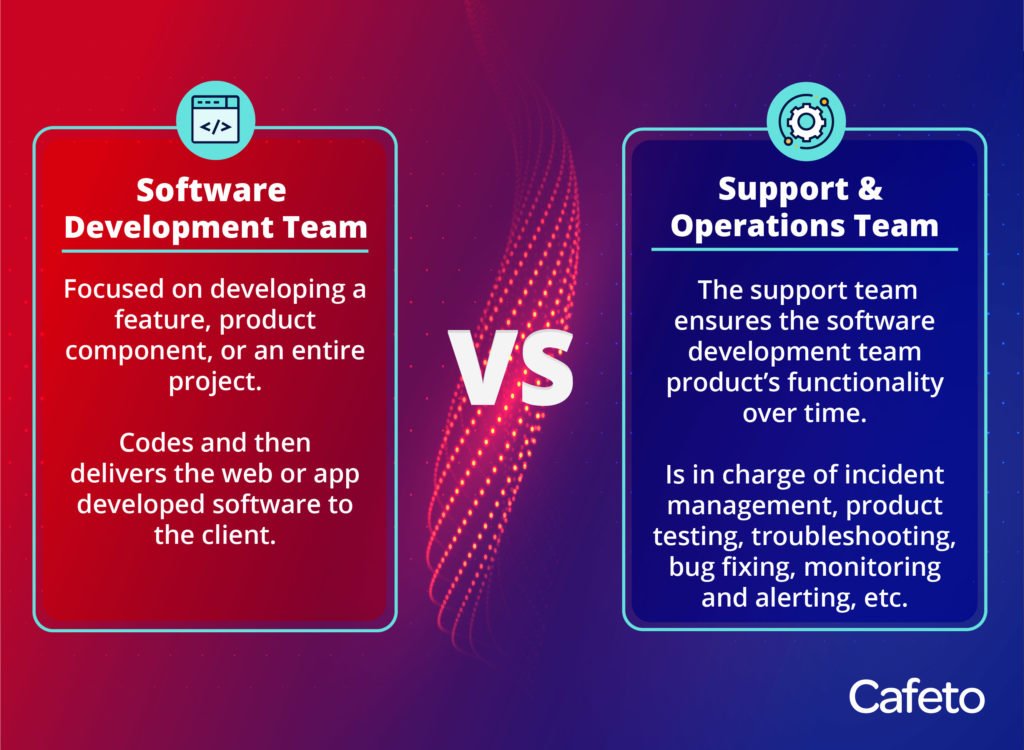December 1, 2021

Customer Support, Nearshore Outsourcing
Why split your dev teams from your support teams.
What’s a software development team? What is a support team? Isn’t the development team the same as the support team? Why would I need both of them in my company?
These are some of the most common questions companies, customers, and even regular people tend to ask. Therefore, having an answer to them will be the topic of today’s blog: Why you should separate your development teams from your support teams.
Let’s start off with the basic concepts you need to know in order to analyze each case.
Nowadays, there are millions of different technologies, coding languages, and tools to solve a problem. From making your browser display the right way, through controlling how you store data in the server, to ensuring that your product meets the basic requirements in privacy and security.

Software development teams.
Not even small businesses could do this without the correct software development organizational structure. That’s why software development teams exist. Focused on developing a feature, product component, or an entire project.
Although, if you’re going to outsource is important to keep in mind that development teams are not permanent. In fact:
“Groups of new cross-functional experts may be assembled to deliver subsequent release iterations or across different product features. While most organizations limit the size of individual teams, developers following DevOps and Agile SDLC frameworks tend to collaborate readily with cross-functional departments and teams.” (Raza, Kidd, 2021)
They contain a wide structure, different roles, and subspecialists to tackle every area of software development. We can find in a team:
- Front-End Developers
- Back-End Developers
- QA Engineers
- DevOps Engineers
- Product Designers
- Project Managers
Besides, they aren’t just developers who write codes. Their activities go far away from that since they have to work together in order to meet an external client’s expectations. Also, their success consists of the business idea, the user journey workflow, the stability, reliability of the software, its quality, risk management, and many more factors they have to overcome.
Support teams
On the other hand, we have support teams, which are very different from the one mentioned before. But if you’re willing to outsource, you can have them just for a limited amount of time. In contrast, they aren’t in charge of writing software and creating apps for the clients, but maintaining the functioning of the solution. The responsibility of this team is to keep a company’s infrastructure, the one made by the software development team, ongoing.
In other words, separating support teams from development teams is key to establishing an organization’s structure. It’s like the saying “pears with pears and apple with apples”. Especially, support teams need to be handling what they know best: monitoring/alerting, troubleshooting, bug fixing, migration to the cloud, incident management, and many more situations coming after a feature implementation.
Equally, support teams as being dedicated to resolving technical issues facing IT users, including the internal workforce and external customers can be divided by its duty:
- Service desk: In charge of helping a company’s internal users.
- Customer service: In charge of helping external customers.
- Technical support: In charge of solving technical issues.
Why separate your development teams from your support teams
Having clarified the issue, we can affirm that a support role is significantly different than a software development position. Its difference is that developers build the application from scratch, deliver it to the client, and then, the support team ensures its operational continuity.
Besides, development teams need to focus on the next assignments, writing codes is a time-consuming process, so mixing operations and having the software development team doing support tasks may affect the quality of a project and the delivery time to customers.
“If something goes wrong with the application, the support team will work with developers to gather information on the problem, but the development group will be the ones that actually write or modify the code to correct the problem. The support team will then move the changes into the QA and Production environments and test it to confirm that the fix resolves the problem.” (Bourne, 2014)
Related topics
In-House vs. Outsourcing Software Development Services–[Pros and Cons]

How much should you pay for an outsourced developer?

Outsourcing Software Development for Startups: Benefits










